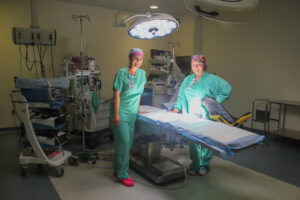 Days in the operating room always start early. Surgery teams change into scrubs and review the day’s cases, then a flurry of activity commences and doesn’t end until every patient has been cared for. The support staff cleans Hillsdale Hospital’s three operating rooms before each operation to ensure thorough sterilization. Nurse circulators review paperwork and talk to patients about their care. From the early start to the late-night hours, the OR thrums with the like-minded purpose to keep every patient safe.
Days in the operating room always start early. Surgery teams change into scrubs and review the day’s cases, then a flurry of activity commences and doesn’t end until every patient has been cared for. The support staff cleans Hillsdale Hospital’s three operating rooms before each operation to ensure thorough sterilization. Nurse circulators review paperwork and talk to patients about their care. From the early start to the late-night hours, the OR thrums with the like-minded purpose to keep every patient safe.
Samantha McAllister and Brittany Shaffer are RN circulators in Hillsdale Hospital’s OR, and this is what every workday is like for them. They’ve trained their minds to adapt to this pace, because they know how important each operation is. “It’s our job to advocate for our patient because they’re asleep and they can’t really talk for themselves,” said Shaffer.
Dr. Parthiv Patel, orthopedic surgeon, has the same patient care philosophy.
“Building trust with our patients is vital,” he said. “We want them to feel confident and informed about their surgery.”
Just as important is the relationship between surgeons and their support staff. Within an operating room, a surgery requires a fully capable and present team. The anesthetist monitors the patient’s airway at the head of the table. Scrub technicians keep every part of the surgery sterile and assist the surgeon when needed. RN circulators work together with the surgeon and scrub techs to ensure the patient is cared for at every step.
Many large hospital systems have so many members on the support staff that each one has an isolated assignment and isn’t prepared for alternate duties. But at a smaller, local hospital like Hillsdale’s, everyone in the OR is ready to respond to urgent situations and no one is confined to one specialty. Because the team can support the surgeon in any type of operation, they can work together to proficiently respond to emergencies.
A significant part of this proficiency is the innovative equipment. For example, the Hana Fracture Table allows orthopedic surgeons to complete anterior hip replacements with less risk of complication and improved postoperative function. “We perform a range of surgeries,” Patel said, “Having the right tools can make a significant difference in the outcome.”
According to Shaffer and McAllister, the mood of an operating room depends on the surgeon. They must remain unreservedly focused, so the room adapts to their needs. Some surgeons bring their own music, and some let the conversation flow around them as their world shrinks to the patient and the task before them.
This atmosphere contributes to the quality of the operations, too, because the team can often communicate with just a glance. When a surgery becomes more complicated, the music may drop away as silence falls over the room. During these intense moments, communication is absolutely vital.
McAllister and Shaffer remember one case where a 10-minute procedure unexpectedly turned into a 4-hour surgery because of a serious development. The support staff stayed hours past their shifts, to see the operation to its successful end. “When stuff like that happens, you just do it and then later you’re like, whoa what just happened?” McAllister said. Through every situation, the team maintains its cohesive mentality.
“The OR staff is really tight knit,” McAllister explained, “Everyone gets along really well…We’re like a big family.”
